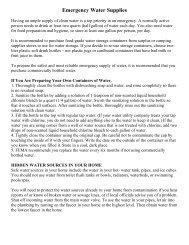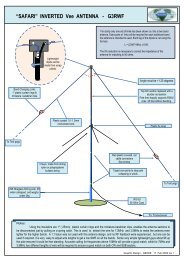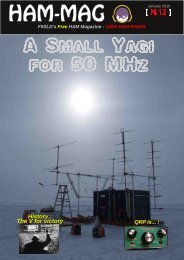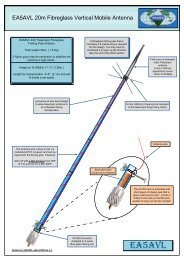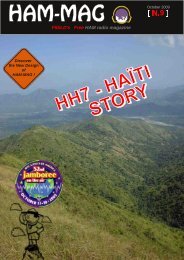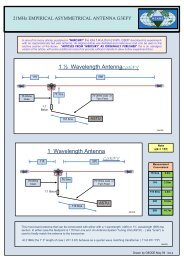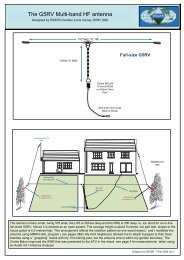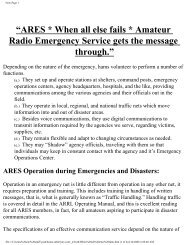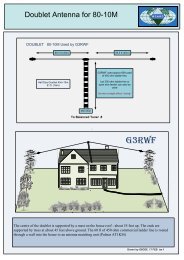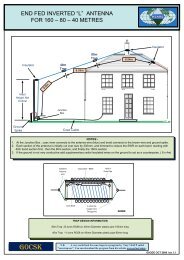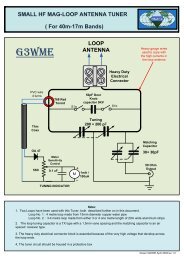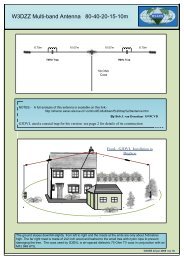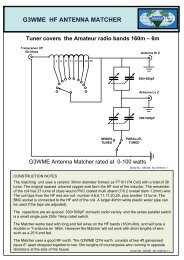HAMMAG - arkansas ares races
HAMMAG - arkansas ares races
HAMMAG - arkansas ares races
You also want an ePaper? Increase the reach of your titles
YUMPU automatically turns print PDFs into web optimized ePapers that Google loves.
HAMMAG<br />
The first free & monthly Emagazine for amateurradio, SWL...<br />
The Tsunamii Amplliiffiier<br />
The 4x4 slliimttenna<br />
Power Source<br />
NUMBER 8 September 2009<br />
http://www.hammag.com<br />
ISSN : 17606470
The HamMag Hall of fame................................................................ 3<br />
4X4 Slimtenna By 4X4LH............................................ 4<br />
DB2TAM MUSEUM By G8DET.................................. 10<br />
The Tsunami Amplifier By DF5XV............................. 11<br />
The DXnews from the Web.................................... 20<br />
The DX Calendar By SM3CVM............................ 23<br />
Alternate Power Source By KD9KC...................... 28<br />
Keep Track WSJT QSOs By SM6NZV.................... 30<br />
Mongolian DX contest By JT1CD......................... 31<br />
Comic's HAM............................................................ 32<br />
Thanks to : 4X4LH, DF5XV, F4FIS, G8DET, JT1CD, K3IXD, KD9KC, SM3CVM,<br />
SM6NZV, VE3SKP<br />
Thanks also to the OM's who believe in this magazine, to all the donators and<br />
OM's who sent helpful messages.<br />
You can contact us by EMail : postmaster@hammag.com<br />
Our websites :<br />
http://www.hammag.com (English)<br />
http://www.hammag.fr (French)<br />
ISSN N.17606470
The Hall of Fame<br />
Donators of AUGUST<br />
NQ9A, Carolyn<br />
N8SHZ, Bela<br />
Richard Vuillequez<br />
Tony Humphris<br />
OM3AG, LadislavW9BF, Robert<br />
Thanks a lot for your support !<br />
To live HAMMAG needs you.<br />
Any help is welcome.<br />
Send us articles, informations.<br />
Send your articles to :<br />
f5sld@free.fr<br />
http://www.hammag.com
The 4X4 Slimtenna<br />
By Eli Kovo 4X4LH<br />
A Reprint by Courtesy of antenneX Online Magazine issue Number: 119<br />
http://www.antennex.com<br />
Some of us prefer to spend a lot of money on towers, enormous in height and price, with lots<br />
of elements antennas and on top of it using the highest legal power. The rest of us, that have<br />
to deduct hard earned money from the family budget, have to make some delving in the<br />
intricacies of efficient transmitting, propagation problems and its many ingredients, if we want<br />
to still enjoy our hobby. It seems that today’s Hi tech brought the hobby to a discouraging state<br />
we don’t build receivers and transmitters any more and on the operating side of it – an<br />
endless chasing of dx for a report and a QSL, which doesn’t seem to be the highest goal of<br />
our hobby.<br />
What is left to us is indeed, directing our efforts in better understanding the proper use of<br />
antennas, evaluating their radiation efficiency, getting to know the fouling behavior of the<br />
ionosphere, along with better differentiating between dBi, dBd, dB, etc. and even find out what<br />
Radiation resistance is.<br />
After long years of thorough combing the literature, internet and other sources of information,<br />
along with building and using many different antennas, I came to the conclusion that one of<br />
the best ways to reach efficiently a distant station for a QSO of not less than 1020 minutes, is<br />
the use of vertical antennas with no more than 150200 watts.<br />
In spite of some “great sages” saying that “a vertical antenna transmits equally bad to all<br />
directions”, my present “antenna of the house” is a pileup busting full wavelength wire Delta<br />
Loop, vertically polarized. I realized that the 1/4 wavelength ground plane antenna and the 5/8<br />
wl antenna needing a good "mirror" underneath, are good choice on top of a car’s metal roof,<br />
but will put you in jeopardy with your wife’s garden and the lawn mower, if you try to bring<br />
them into your home station for HF.<br />
I also realized that although a three or four elements Yagi beam concentrates its power in a<br />
narrow horizontal pattern, its vertical “take off ” suffers from a high radiation angle of ~30°,<br />
loosing a lot of dB’s in excessive number of hops to the ionosphere, while a good vertical<br />
monobander reaches the dx with less hops, with almost the same strength!<br />
I further discovered that following the request of amateurs looking for a single knob (main’s<br />
on/off) “no tuning” transceiver, made the manufacturers provide rather compact transceivers<br />
but without any way of antenna tuning and loading. Instead promoting an external ATU to be<br />
added to the paraphernalia of the station with, of course, additional expenditure. It happens<br />
also because of the wish of amateurs and in many cases their necessity to use one single<br />
antenna for as many bands as possible no matter how bad the transmission is. Here lays one<br />
of the misunderstandings of many members of our fraternity. When feeding a dipole with its<br />
basic frequency it was built for, we get its basic well known clean pattern. Using the same<br />
dipole length on other frequencies with an ATU as a mediator, correcting wrong impedance,<br />
reactance and SWR for the tx to be happy, BUT:
1) The antenna will not provide the length the wave is looking for, according the rules of<br />
Physics.<br />
2) The clean basic pattern of the dipole is distorted into many additional lobes on account of<br />
the main lobe.<br />
3) The low take off angle desired for dx is elevated (to warm the clouds), causing more<br />
hops on its long way to the dx station.<br />
4) The radiation efficiency becomes so low that out of our 150 watts only 15 poor watts get out<br />
on the air.<br />
5) The ionosphere, acting as a mirror, absorbs some of our signal as a “payment for its<br />
services”, swallowing 810dB (for each hop) of our miserable signal, arriving at the dx station<br />
with less then 1 watt.<br />
A correctly transmitting antenna is the best “amplifier” I know. A 3 dB gain doubles the power<br />
of your signal and a 6 dB quadruples it. Your 150 watts are sent out as 300 watts! Add the<br />
equivalent gain of low take off angle transmission (less hops) and you are better off than a<br />
kilowatt!!<br />
I brought this long preface for my hobby fellows, pointing out some of the pitfalls. If we get<br />
aware of them we will benefit by better understanding of the how’s and why’s of antennas and<br />
enhance our station performance. This will hopefully encourage us to build and use simple,<br />
cheap and efficient, low take off angle monoband verticals.<br />
Here comes my modification of the Slim Jim antenna which I call “The 4X4 Slimtenna”.<br />
The esteemed Slim Jim antenna was invented by Fred Judd G2BCX on the basis of the J<br />
Pole antenna, which was based on the German Zepelin antenna. This one was an endfed<br />
dipole, fed by a 1/4 wavelength open wire ladder section, hanging out beneath the big airship.<br />
It was actually invented by an Austrian engineer in 1908 intended for use in balloons in a<br />
suspended mode. Niels Rudberg OZ8NJ found this astounding fact in an old textbook<br />
published quickly in the same year by Dr. J. Zenneck – Professor of Physics in Muenich<br />
(RadCom June 2006).<br />
Pic1 The Zepp and J Pole, the development of the Slim Jim and its upgrade for HF<br />
“The 4X4 Slimtenna”
DB2TAM – Thorpe Abbotts Museum<br />
The Chelmsford Amateur Radio Society (CARS) will be operating as GB2TAM from the Thorpe<br />
Abbotts 100th Bomb Group Memorial Museum, in Norfolk, on Saturday and Sunday 12/13th<br />
September.<br />
Thorpe Abbotts was a Second World War air station, which was the home of the U.S.A.A.F<br />
100th Bomb Group from 1943 to the end of the war in 1945. During that time, 753 aircrew<br />
made the supreme sacrifice and since then hundreds of veterans have returned to Thorpe<br />
Abbotts and continue to do so to this day. Although much of the air station has now gone, the<br />
control tower still stands and has been restored to its former glory by a group of dedicated<br />
volunteers over the last 25 years, most of who are still working for the museum.<br />
GB2TAM has been organised to coincide with the weekend of the 100th Bomb Group reunion,<br />
which is held each year in Albuquerque, New Mexico. It is hoped that band conditions allowing,<br />
we will be able to make contact with the reunion and possibly speak to some of the dwindling<br />
number of veterans who will be attending.<br />
The station will be operating on all HF bands using SSB as well as 2m FM and will be pleased<br />
to contact stations regardless of location. A GB2TAM QSL card will be available for all contacts<br />
which will show the control tower as it is today in a pristine restored condition.<br />
100th Bomb Group<br />
http://100thbg.com/<br />
100th Bomb Group Thorpe Abbotts Museum<br />
http://www.100bgmus.org.uk/<br />
100th Bomb Group Memorial Museum<br />
http://www.aeroflight.co.uk/mus/uk/1b/100thmus.htm<br />
The Chelmsford Amateur Radio Society run courses for the Foundation, Intermediate and<br />
Advanced exams To find out more contact the CARS training coordinator Clive Ward G1EUC<br />
on<br />
Tel: 01245224577<br />
Mob: 07860418835<br />
Email: training2009@g0mwt.org.uk<br />
Web: http://www.g0mwt.org.uk/training/<br />
Credit: GB2TAM article by Mark Sanderson M0IEO<br />
Attached Pictures:<br />
Thorpe Abbotts Control Tower<br />
by John Bowen G8DET
The DF5XV's Project Tsunami<br />
or 3 years of work due to a bet<br />
about a crate of Bitburger beer<br />
Burkhard, DF5XV, www.classicbroadcast.de , owns a MonsterPA of R&S called VK20. The live<br />
weight of this PA amounts to 1.6 metric tons, it needs a big room on its own with a defined<br />
supply and exhaust air and its output reaches frightening 20 Kilowatts, even for RTTY. As a<br />
driving transmitter a R&S SK01 is required. Burkhard has an official permission of the BNA for<br />
20 KW on shortwave for broadcast, although not for ham radio. Such enormous values of<br />
transmitting power challenge even the creativity of an experienced high frequency engineer.<br />
Well, three years ago, the author of this article placed a bet against Burkhard to build a power<br />
amplified with more than half the output power of the VK20 in SSB mode, yet would fit the trunk<br />
of a compact car as well as a manageable weight. Burkhard’s answer: No way! So the race<br />
was on!<br />
After three years have passed, the project with working title „Tsunami“ is finally completed.<br />
Even the additional difficulty of a minimal required input power of only 100 Watts, achieved by<br />
every amateur transceiver, in order to attain the full SSB transmit power of approximately 15<br />
Kilowatts was accomplished. A total amplification of about 21 dB is technically very ambitious<br />
as it was not the goal to build a power oscillator. The tube which satisfies the technical<br />
requirements of the project „Tsunami“ for sure without reaching its limits is the 4CX10000D.<br />
According to the Eimac spec sheet for SSB linear amplification applications, this tetrode<br />
features a plate dissipation of 12 Kilowatts (Ua, max: 7500 V, Ia, max: 4 A) and provides a<br />
continuous output of 16 Kilowatts within the guaranteed values by Eimac. The plate input<br />
power results in 25 Kilowatts in this case. If the heating power of 563 Watts, the power of the<br />
screen and control grid as well as for the fan and other system requirements is added, a<br />
powerfull threephase alternating current adapter is necessary. The fuse box of the single<br />
family house owned by the author provides a connection with 3 times 40 Amps at 400 Volts,<br />
hence a continuous power rating of 28 KVA. This is barely enough for a 16 Kilowatts<br />
continuous carrier – doing one’s laundry in a washing machine at the same time should be<br />
avoided, though.<br />
Fig.1: Size comparison: 4X150A, Pv = 250 W / 4CX1500B, Pv = 1500 W / 4CX10000D, Pv =<br />
12000 W The 322 holes in the 8 mm floor panel (underneath the transformer) are used as a<br />
cooling air intake.
Of course, in SSB mode this calculation is different. Without a voice compressor the average<br />
power in an OMtypical continuous QSO is only 20 to 25 percent of the peak power, with the use<br />
of a compressor the average power increases up to 30 percent. The plate highvoltage<br />
transformer of the Tsunami power amplifier is designed for 10 KVA, because for a SSB output<br />
power of 15 Kilowatts with an amplifier efficiency of 65 percent and an average voice power of<br />
excessive 33 percent (with dreadful contest modulation), the required transformer power<br />
amounts to 7.6 KVA. Thus, a 10 KVA transformer is more than sufficient to conduct<br />
comprehensive continuous QSOs in SSB. In case one listens to the dialog counterpart once in a<br />
while, the dimensions of the plate transformer is downright luxurious.<br />
Fig. 2: 10 KVA threephase alternating current tape wound hypersil plate transformer, weighs<br />
only 70Kilograms. Underneath the transformer one can see the 322 holes of 12 mm diameter,<br />
allowing for an especially quiet cooling air intake also cooling the transformer.<br />
Additionally, the Tsunami power amplifier uses a 1.2 KVA toroidal core transformer for<br />
theremaining voltages. To power on the whole amplifier, a 1 VA transformer on the<br />
centralmotherboard is allotted. The turnon procedure is designed to be very soft and after<br />
exactly 10seconds the amplifier is ready for full power.<br />
Fig. 3: Mainboard with 1200 VA toroidal core transformer (green connectors: 7.5 V 75 A<br />
heating current), 1 VA transformer (center right, partly beneath golden resistor) for poweringon,<br />
7800 V threephase alternating current rectifier (top right), gold colored poweringon resistors (3<br />
x 68 Ohms, 100 Watts, lower left), parts of the electronic controller of the control grid (center left)
After the dimensions of the main electronic components were determined, it was the<br />
constructor’s ambition to build the world’s only desktop output stage using a 4CX10000D<br />
which would fit on any reasonable station table. It is impossible to construct a smaller 15 KW<br />
SSB power amplifier: the total height of the “Tsunami” is only 31 cm. There is a voltage of 1000<br />
V but only 8 mm of space between the bottom of the housing and the tube socket. Between<br />
the plate and the housing cover there is a voltage of 7000 V but only a gap of 22 mm. Although<br />
these distances are sufficient even at high humidity (e.g. after DX activity), smaller clearances<br />
are unfeasible. Also, the width of the amplifier is reduced due to the plate transformer and the<br />
roller inductor to an optimum of 57.5 cm. The same applies for its depth: 58.5 cm. A smaller 15<br />
KW SSB power amplifier is definitely impossible! The air flow for cooling was optimized. Cold<br />
air is sucked in bellow the anode transformer, keeping it cool at the same time. The warm air is<br />
then taken out on the shortest path above the plate. Of course, the best and most quiet fan<br />
available is used and mounted to the housing with a rubber joint to minimize vibrations. Also,<br />
on reception, the fan speed is reduced to further minimize noise. Still, the radial fan is<br />
dimensioned to absolutely be on the safe side, so the air flow through the amplifier tube is<br />
increased when transmitting, which is not quite inaudible. But the amplifier stays cool even<br />
during nonstop operation.<br />
Fig. 4: On the bottom: threephase alternating<br />
current hypersil plate transformer with 10 KVA,<br />
on top the central controller board with a toroidal<br />
transformer with 1200 VA (green connectors:<br />
7.5V / 75 A heating current), fan (blue), 7 Zener<br />
diodes (50 W each) for the screen grid (behind<br />
the toroidal transformer). Two Zener diodes<br />
(50W each) as bias voltage of the precise<br />
electronic voltage control for the control grid are<br />
mounted to the rear panel. Plate fuse and feed<br />
through capacitor (top right), front panel with<br />
display board and digital control system for all switching operations (10 ms timing) of the<br />
amplifier as well as the control logic for the motors of two variable vacuum capacitors (left).<br />
The configuration of the power amplifier without the front panel is depicted in Fig. 5. A ribbon<br />
cable connects the central main board with the display and control board on the back of the<br />
front panel. This display and control board also contains the complete processing logic of the<br />
amplifier as well as the Darlington transistors to directly control of all power relay. The power or<br />
RF relays will definitely not be triggered under load. Therefore, even the vacuum relays are<br />
working under optimal conditions. Fig. 6 shows the configuration of the front panel without<br />
pushbuttons and switches. By the way: the advantage of LED displays is their ability to display<br />
PEP values without indolence. In order to provide a stable operation of an power amplifier<br />
featuring an amplification of 21 dB, a transformation of the input voltage to the required driving<br />
voltage of the tube (approx. 245 V), an excellent RF insulation between tube input and output<br />
as well as additional neutralization of the tube is required. The insulation between tube input<br />
and output was achieved by galvanically grounding the screen grid and the installation of an<br />
additional mechanical perforated grid between screen grid and the plate of the tube at the<br />
same time. This mechanical effort depicted in Fig. 7 has never been reported before in public<br />
descriptions, so this might be a new idea. The screen grid was also grounded using 8 low<br />
capacitance connections. Fig. 7 also presents the RF plate choke of 112 uHy and the 8 KV<br />
feed through capacitor. The plate choke was supplied with an adjustable short circuit ring<br />
(silver wire with Teflon hull) in order to put two resonance points in the center between<br />
amateur bands.
But the results of superior RF production with unrestrained power compensate for the costly<br />
calibration work. With an input power of only 5 Watts an output of 750 Watts is achieved. With<br />
30 Watts input the output power reaches 4400 Watts. Even with an SSB input power of 100<br />
Watts the gain remains constant, i.e. the output power amounts to (40 m) 14.6 KW. The tube is<br />
not really challenged and demonstrates wellbeing and nonchalant performance. Only the<br />
terms of license are not really humored if the antenna shall be used as a load resistor.<br />
Unfortunately, a 5 KW dummy load by Bird was not really humored as well and quit its service<br />
with a loud bang after about 6 seconds of a 10 KW load (taking the picture for figure 14 took<br />
this long). All in all the construction was the sole goal of this project, besides the crate of<br />
Bitburger beer in case the bet should be won, of<br />
course …<br />
Fig. 8: Grid input: adjustable input inductors (bottom),<br />
HF input resistor (right of center), RF transformer (top<br />
right), 11 pole band switch (bottom right), other<br />
details: see text<br />
The output transformer network (pi filter) can be seen in Fig. 9. Roller inductor and counter dail<br />
are on the right, the massive 10 m inductor at the top of the image. The 500 pF / 15 KV<br />
vacuum rotary capacitor in conjunction with the 2500 pF / 5 KV vacuum rotary capacitor<br />
determine the adjustment of the tube output impedance (about 3700 Ohms) to the 50 Ohms of<br />
the coaxial connector, based on the ratio of their capacitances. Of course, the 500 pF is<br />
primarily responsible for resonance adjustment. For a pi filter consisting of exactly these<br />
components, an operating frequency in the range of 1.8 – 29.7 MHz can be selected<br />
continuously. Furthermore, the Q of the pi filter can also be continuously adjusted according to<br />
specific needs. These are obvious advantages over pi filter with RF switches. The vacuum<br />
rotary capacitor can be turned while under full RF load without any problems; its variation<br />
range is about 1:100 compared to 1:10 for variable air capacitors. The only disadvantage of<br />
such a circuit is the high cost of its components in contrast to a switched network with air rotary<br />
capacitors. Aside from this, the usual components would quickly go up in smoke due to the<br />
available RF output power. A keyed signal (1 KHz, keyed at 20 Hz, onoffratio 1:2) is used for<br />
a quick and precise adjustment of the pi filter. The signal is looped into the microphone cord<br />
and hence provides perfect SSB adjustment: http://www.mydarc.de/dc9tm/ .<br />
The author only has a 100 W transceiver available, which is the reason why the measurement<br />
of the output power ends at 14.6 KW SSB (40m). In case this is not enough, the Tsunami<br />
power amplifier can produce even more output power by increasing the input power. But it<br />
remains the operator’s decision to observe the limitations, which is a question of character.<br />
Fig. 9: Pi filter with roller inductor and counter dail (top<br />
right), 10 m coil (top center), two motor controlled<br />
vacuum rotary capacitors, 500 pF (15 KV) on top and<br />
2.5nF (5 KV) below. Bottom right: two MP capacitors (32<br />
uF / 6 KV each, so 16 uF / 12 KV combined) for the plate<br />
voltage
Fig. 10: Power amplifier without back<br />
board, the motors for the two vacuum<br />
Fig. 11: Finished Tsunami power<br />
amplifier; top view, the brand new tube<br />
is shining happily!<br />
Fig. 12: Tsunami power amplifier; back<br />
view (left to right: 4 main fuses (circuit<br />
breaker), threephase alternating<br />
current connection (5 x 32 A, 400 V),<br />
PTT (cinch), output (7/16), input<br />
(SO239))<br />
Fig. 13: Finished Tsunami power<br />
amplifier on a sustainable acryl glass<br />
table, custommade<br />
Fig. 14: Finished Tsunami power<br />
amplifier: Does anybody know of a<br />
smaller 15 KW SSB output stage?<br />
Fig. 15: Detailed view of the laser<br />
inscribed front panel
Data of Tsunami RF Linear Amplifier<br />
RF linear amplifier covers all amateur bands from 1.8 MHz to 29.7 MHz<br />
3 Power supply transformers 10000 VA , 1200 VA & 1 VA<br />
Plate voltage at full output power 6500 V<br />
Screen voltage, stabilized<br />
1000 V<br />
Grid voltage, regulated<br />
245 V +/ 20 V<br />
Filament<br />
7.5 V / 75 A<br />
Input SWR in the middle of band<br />
Gain (1.8 – 29.7 MHz)<br />
Neutralization<br />
Isolation between input and output<br />
Output with:<br />
160 m – 30 m 1 : 1.25<br />
20 m 1 : 1.35<br />
15 m 1 : 1.45<br />
12 m – 10 m 1 : 1.65<br />
20 21.6 dB<br />
1.8 – 29.7 MHz:<br />
45 – 50 dB<br />
5 W Input: 0.75 KW Input: SSB Signal:<br />
10 W Input: 1.5 KW 33% of full 1 KHz Modulation<br />
20 W Input: 2.9 KW on / off Ratio 1:2, Interruptions: 20 Hz<br />
30 W Input: 4.4 KW<br />
40 W Input: 5.8 KW Equipment:<br />
50 W Input: 7.3 KW R&S 20 KW Dummy Load<br />
60 W Input: 8.7 KW Bird Power Meter<br />
70 W Input: 10.1 KW<br />
80 W Input: 11.6 KW Measurements<br />
90 W Input: 13.1 KW on 7.1 MHz<br />
100 W Input: 14.6 KW<br />
Harmonic output<br />
50 dB below rated output<br />
Intermodulation distortion<br />
35 dB or better<br />
Tube Eimac<br />
4CX10000D<br />
Input network:<br />
1:9 Transformation, 450 Ohm, 500 W HF Resistor, Tube Input Reactance Compensation &<br />
Neutralization for each band, 11 pol. bandswitch, two levels<br />
Output network:<br />
Roller inductor 20 uH & 2 motorized vacuum capacitors 500 pF / 15 KV and 2.5 nF / 5 KV<br />
Metering: Display of all parameters – no switching<br />
Computer control of all switching functions: No relays switching under power conditions<br />
Soft start inrush, 10 sec delay time for full power<br />
Turbine blower with 2 speeds<br />
Well regulated screen and grid supply for +ve and –ve currents as well as current limiting to<br />
protect the tube and minimize the IMD. It´s impossible to override the screen and grid<br />
dissipation at any working conditions<br />
The finish is of high quality black eloxial aluminia<br />
Dimension<br />
Weight<br />
Accessory (for IcomTransceivers)<br />
Price:<br />
575w x 310h x 585d mm<br />
132 Kg<br />
Module for optimized tuning (1 KHz; on / off: 1:2, 20 Hz)<br />
Very low: About 1.7 €/W (1.7 €/W x 14.6 KW = 24.8 K€)
Some comments on the measurements<br />
Measurements of the output power of the Tsunami power amplifier revealed a decreased output<br />
at higher frequencies. It turned out that this is mostly due to the ICOM transceiver (IC 7400) as<br />
its output is reduced when frequency is increased. Although it still pretended an output power of<br />
100 W on its display, but the actual output at 10 m was only 74 W for example (with tuner). In<br />
general, the RF parts used in the Tsunami output stage are not small in terms of space due to<br />
their high performance. Hence, the signal paths and stray capacitances are inevitably larger as,<br />
for instance, in a 1 KW power amplifier. Still, the Tsunami features an impressive output power<br />
across the full frequency range from 160 m up to 10 m. The complex roller inductor allows for a<br />
continuous variation of the operating frequency across a broad frequency range, but the<br />
disadvantage is that the requirements of frequency variation, e.g. the skin effect, cannot be<br />
accounted for due to the constant turns of the coil. In switched pi filters, the respective inductor<br />
parameters like coil diameter, thickness of the conducting layer as well as the distance between<br />
the coils can be adjusted according to the desired frequency range, thereby a uniform output is<br />
achieved across the full frequency range. However, the Q of the output circuit predetermined by<br />
a fixed number of taps, whereas it can be continuously adjusted using a roller inductor.<br />
For the Tsunami project, particular attention was devoted to resilience and reliability so the roller<br />
inductor that is used was chosen from a set of 8 different inductors according to these aspects.<br />
With a modification of its contact finger, the shortest possible contact path between roller<br />
inductor and the two vacuum rotary capacitors could be achieved. Also, motorized capacitors<br />
were a requirement for the best possible placement of the two pi filter capacitors. It is only due<br />
to these artifices that the frequency range of the Tsunami power amplifier completely covers<br />
shortwave, including the medium wave region of the 160 m band. The small variation in the<br />
amplification factor within the single bands can be easily compensated with a variation in input<br />
power. The performance of the fully assembled Tsunami is well beyond traditional amateur radio<br />
means. Of course, one has to especially deal with the performance of antennas, antenna<br />
couplers, cable connections and so forth. A 165 m loop antenna, a reasonable open wire feeder<br />
and a well dimensioned antenna coupler permit for smooth operation on all bands discussed<br />
here, but excessively exceeding legal constraints should not be considered. As the author<br />
abides to the rules, the Tsunami is up for sale – but of course the bet has to be won first.<br />
Of course, interfering factors also increase with increasing power. So one has to deal with<br />
complications like, e.g. for the author, RF destroying DSL modems. Therefore, a great deal of<br />
attention has to be paid to control strayed RF in the system. As soon as ferrite beads were<br />
attached to the 230 V and 400 V power cords as well as the PTT and HF control cables,<br />
everything was fine again.<br />
So are destroyed DSL modems acceptable for fellow human beings? Of course not! As the<br />
German philosopher Max Weber says: Every human is responsible for his own bondage. This<br />
can be translated to: One should only create as much power as circumstances and fellow<br />
humans permit. ??!
Accessories / Miscellaneous<br />
Fig.16: Proof of output power: With<br />
an inputof only 70 W on 40 m the<br />
Tsunami poweramplifier provides an<br />
output of 10.1 KW.<br />
Fig. 17 – 19: The exclusive Tsunami capable<br />
antenna coupler in acryl glas, working up to 15 KW<br />
SSB output in a frequency range from 160m up to<br />
10 m. The integrated power meter (original Bird)<br />
exactly indicates forward and reflected<br />
transmission power, allowing for quick and<br />
accurate adjustment of the antenna. The coupler<br />
sits ontop an amplifier with a 4CX1500B, which<br />
provides an output power of at least 2 KW SSB at<br />
a height of 16.5 cm.<br />
Fig. 20: Ferrite bead for 3 x 400 V<br />
power cord, weighing about 4 Kg.<br />
The author would like to thank his radio<br />
colleagues for the valuable support and<br />
assistance during the realization of the<br />
Tsunami project.
THE DX NEWS<br />
From the Web (tnx opdx, 425 dx news, arrl...)<br />
3D2, FIJI<br />
Operators Jacek/SP5EAQ and Jacek/SP5DRH will be active as 3D2MJ and 3D2KJ,<br />
respectively, from Viti Levu (OC016), starting October 1st for four weeks. Activity will be on all<br />
bands, but with an emphasis on the lower bands. They plan to use two stations with small<br />
amps and vertical antennas. QSL via their home callsigns.<br />
4W, TIMORLESTE<br />
Currently, two operators are active from here. Al, CT1GPQ, now active as 4W6AL, will be<br />
there until October 3rd. Remember, this is "NOT A DXpedition"! CT1GPQ is in TimorLeste<br />
with a medical team and radio operations will take place only during his spare time. He was<br />
heard this past weekend on 20 meters CW at various times between 08001300z. QSL via<br />
Toze, CT1GFK. Online log is now available at: http://algarvedx.com<br />
Second operator is Chris, VK4FR, now active as 4W6FR, will be there until midOctober. He is<br />
also on a work assignment. Chris was heard this past weekend mainly on 30 and 20 meters<br />
using PSK31. QSL 4W6FR via VK4FW.<br />
5B, CYPRUS (New IPA Op!)<br />
Gab, HA3JB, will be active as 5B/HG3IPA between September 25th and October 2nd. This is<br />
a new IPA activation and is valid for HAIPARC Award (Hungarian International Police<br />
Association). Find IPARC Award info at: http://www.ha3jb.com/award.html<br />
Gab plans to be in the CQWW RTTY Contest (September 2627th). Online log will be<br />
available on his Web page at: http://www.ha3jb.com<br />
9H, MALTA<br />
Members of the Dutch Society of Radio Amateurs (VRZA) will once again be active using their<br />
special callsign 9H9PA from Qawra between September 528th. Activity will be on 806 meters<br />
using CW, SSB and the Digital modes. QSL via PB9ZR, by the Bureau or direct to: Ruben van<br />
der Zwet, Van Speykstraat 238, 2161 VT Lisse, The Netherlands. NO IRC coupons, they are<br />
not valid anymore in the Netherlands (2 USDs only).<br />
PLEASE NOTE: Operators will also operate under their individual callsigns. The following<br />
callsigns were mentioned: 9H3AB (QSL via PA1SL), 9H3DZ (QSL via PA2AM), 9H3FD (QSL<br />
via PA3FHR), 9H3ON (QSL via PG9W), 9H3S (QSL via PA3HGP), 9H3X (QSL via PE1NGF),<br />
9H3YM (QSL via PE1OFJ) and 9H3ZR (QSL via PB9ZR).<br />
9M6, EAST MALAYSIA<br />
Operators Miki, JJ2CJB/AC2AI will be active as 9M6/JJ2CJB from "Langkah Syabas Beach<br />
Resort" located near the city of Kota Kinabalu on the Island of Borneo (OC088) for the<br />
CQWW DX SSB Contest (October 2425th). He plans to run 400 watts into a Force12 C4<br />
beam. QSL via LoTW, eQSL or the JA Bureau.<br />
AH0, MARIANA ISLANDS<br />
Kuny/W1FPU (7L1FPU) and his nineyear son Yoshiki/ KH0UA (JF1UCV), Tomo/N2QP<br />
(JQ1OCR), his wife Yuri/KE7TWK, Hajime/AH0BR and Moto/W1NDE will be active from the<br />
Mariana Islands between September 47th. Activity will include a Multi/Multi entry in the All<br />
Asian DX SSB Contest (September 56th) as AH0BT. QSL via 7L1FPU, by the Bureau and<br />
direct.
EA6, BALEARIC ISLANDS (EU004)<br />
Adrian, AA5UK, will be active as EA6/AA5UK from Ibiza (JM09tb), October 1429th. Activity<br />
will be holiday style on 16010 meters using mostly SSB and various Digital modes. Also, look<br />
for satellite activity on various birds. He will also be active during CQWW DX SSB Contest<br />
(October 2425th). QSL via his home callsign, by the bureau, LoTW or eQSL.<br />
FT/G, GLORIOSO ISLAND (Update)<br />
Didier, F5OGL, Glorioso 2009 team leader, announced this past week (on August 19th) that<br />
"the Glorioso 2009 team has in hand the flight tickets from Paris CdG to the St. Denis Reunion<br />
Island airport. The departure is scheduled on September 11th and the return on October 8th.<br />
The information about the French Forces Transall flight from Saint Denis to Grande Glorieuse<br />
will be published as soon as the FASZOI Hq will have confirmed them. (FASZOI = French<br />
Armed Forces for the South Indian Ocean Zone) The stay on Grand Glorieuse is considered<br />
having about three weeks length. All the gear has been picked up and is now ready packed on<br />
pallets to be sent to the Reunion island in the next few days. Thanks especially for that to the<br />
Provins ARC, F6KOP members Serge, F6AML and Frank, F4AJQ." For more details and<br />
updates, visit the FT5GA Web page at: http://glorieuses2008.free.fr<br />
HL9, SOUTH KOREA (Update/Attention PFX Hunters!)<br />
Mike, KE7WRJ, will be here for over 2 months starting September 9th. He plans to be active<br />
as HL9QST, September 10th, but no later than 11th. This is a rare prefix only assigned to U.S.<br />
Service members assigned to Korea. His tentative schedule is to operate from 4 different<br />
locations in South Korea as follows: September 1012th: Seoul September 1424th: Camp<br />
Casey September 25thOctober 18th: Camp Humphreys + October 1929th: Camp Carroll <br />
October 30thNovember 13th: Seoul<br />
Activity will be on 4010 meters, depending on the propagation, using CW and SSB.<br />
Operations will be at least 8 hours a day during the week and longer over the weekends. Look<br />
for him to be in both the Extra and General portions of the bands. His equipment will consist of<br />
a 5000A by Flex Radio, a "3 element Yagi in a Bag" from Super Antennas. QSL via KE7WRJ,<br />
direct or LoTW.<br />
JD/O, OGASAWARA<br />
Operators Makoto/JI5RPT (JD1BLY) and Taka/JO2JDJ (JD1BLP) will be active from<br />
Chichijima Island (IOTA AS031) between September 1922nd. Activity will be on 406 meters<br />
using the satellites, CW, SSB and Digi modes. QSL via their home callsigns. Log search for<br />
JD1BLY will be available on the following Web site: http://www.ji5rpt.com/jd1/<br />
LX, LUXEMBOURG<br />
Operators Theo/PA1TK, Kees/PA5WT and Rob/PA3GVI will be active as LX/homecall<br />
between September 47th. Look for Kees and Rob to focus on the HF bands between 8010<br />
meters using CW and SSB. While Theo operates in the IARU VHF Contest on 144 MHz (2m).<br />
QSL via their home callsigns.<br />
P29, PAPUA NEW GUINEA<br />
Allan, VK2GR, will be active as P29CW from the Western Province between September and<br />
December. Activity will be only during his spare time because he is there working with<br />
"Australian Doctors International" ADI http://www.adi.org.au<br />
Due to the limited availability of power, Allan may not be active on the many field trips during<br />
his stay. QSL direct to Tommy, VK2IR, with 3 USDs or new IRCs. PLEASE NOTE: DO NOT<br />
send QSLs to the Papua New Guinea address.
SN120, POLAND (Special Event)<br />
Look for special event station SN120OSP to be active between now and October 31st. Activity<br />
will be on all bands and modes. Operations are to celebrate the 120th anniversary of the<br />
auxiliary fire brigade of the Polish City "Gorowo Ilaweckie". QSL via SP4CUF.<br />
SPECIAL EVENT<br />
The ARRL announced that the Hiram Percy Maxim Birthday celebration is back! This year, the<br />
ARRL is honoring the 140th anniversary of the birth of the League's first president and cofounder.<br />
Hiram Percy Maxim, W1AW, was born September 2, 1869 and died February 17,<br />
1936. The special event is open to all amateurs, and the goal is to work the stations adding<br />
/140 to their callsigns, and contact as many as possible during the event period, September 2<br />
9th.<br />
A special certificate is available for making at least 25 contacts with /140 stations, with<br />
endorsement increments of 25, and a maximum endorsement of 100. Who is eligible to sign<br />
/140? ARRL members who hold ARRL appointments, ARRL elected volunteers (such as ARRL<br />
Directors and Section Managers), ARRL Life Members, ARRL Head quarters staff and VEs,<br />
AECs, QSL bureau workers and awards managers (who are ARRL members).<br />
The complete list of eligible positions can be found on page 20 of the September 2009 issue<br />
of QST. For more details, read ARRL Letter (Aug. 21st, Vol. 28, No. 33) or go to the ARRL<br />
Web page at:<br />
http://www.arrl.org/news/stories/2009/08/17/11025/?nc=1<br />
T31, CENTRAL KIRIBATI<br />
Craig, N3BQR, will be on a research trip to Phoenix Island (OC043) and expects to be active<br />
as T31AA between September 1025th. Part of his research will involve Craig trying to land on<br />
at least six of the eight islands in the chain, although this is subject to local sea state<br />
conditions. Activity is expected on 20 meters SSB using vertical and/or dipole. QSL route to be<br />
announced later.<br />
TI5, COSTA RICA<br />
Operators Lewis/WW4LL and Andrei/EW1AR/NP3D will be active as TI5/homecall between<br />
September 2328th. Activity will be on all bands using RTTY, SSB, and perhaps some CW.<br />
QSL via LoTW, also direct per (QRZ.com) address.<br />
XW, LAOS<br />
Bruce, XW1B, will be active during the CQWW DX CW Contest (November 2829th) as a<br />
SingleOp/AllBand entry. QSL via E21EIC.<br />
ZK2, NIUE<br />
Koji, JM1CAX (exD2NX), will be active as ZK2NX between September 1925th. Activity<br />
should be on all bands, especially 30/17/12 meters, mostly CW, but some SSB. QSL via<br />
JM1CAX, by the Bureau or direct.
DXCALENDAR<br />
By SM3CVM<br />
The calendar is available at http://www.sk3bg.se/<br />
7/9 WEST EAST MALAYSIA and BRUNEI; 9M8QQ, 9M6QQ and V85QQ<br />
from Sarawak (9M8QQ), Sabah (9M6QQ) and Brunei (V85QQ) by DF5UG. (QSL via home<br />
call.<br />
30/9 CROZET I.; FT5WO AF008<br />
by F4DYW says he will be working at Alfred Faure Base on Ile de la Possesson. He plans to<br />
operate on 20, 15 and 40 metres SSB during his spare time, using 100 watts and dipoles.<br />
QSL via home call, direct or bureau. Look for updates on<br />
http://f4dyw.free.fr/index.php?langue=fr&contenu=ft5wo.html<br />
31/9 MONGOLIA; JU85TTC<br />
to celebrate the 85th anniversary of "Technique Technology College of Mongolia. Activity over<br />
the past weekend has been on 20 meters CW. QSL via JT1DN.<br />
ca 2/10 CHILE; CE73RG<br />
The Radio Club Rancagua (CE4RG) was founded on July 22, 1936, and the 73rd anniversary<br />
will be celebrated with the special event station. Operation will take place in CW, SSB and<br />
PSK on 80/40/20/17/15/12/10m. QSL via CE4WJK.<br />
3/10 TIMORLESTE; 4W6AL<br />
from Timor Lorosae by CT1GPQ. Activity will be on 40/30/20/17 meters SSB, RTTY and<br />
preferably CW. His station setup will be an Icom IC706 MK2g, a dipole for 40 and 30 meters<br />
and square loops for 20 and 17 meters. Pilot station and QSL Manager is Toze, CT1GFK. The<br />
pilot station will be in daily contact with CT1GPQ. Any questions or suggestions should be<br />
sent to star@algarvedx.com<br />
Activity logs will be online (possibly daily) on http://algarvedx.com/<br />
All information will be sent first via the Algarve STAR DX Team Mailing List. Subscriptions are<br />
available on team's WEB site. PLEASE NOTE: This is "NOT A DXpedition"! CT1GPQ will be in<br />
TimorLeste with a Medical Team and radio operations will take place only during his spare<br />
time.<br />
31/10 JAPAN; 8J6SL AS077<br />
from the Kumamoto Museum to celebrate the 100th anniversary of Hisatsu (Railroad) Line<br />
(Steam Locomotive) on the Island of Honshu (JIIA AS077001). Activity will be on all bands<br />
and modes. Possibly 5 stations will be on the air. QSL via the JARL Bureau.<br />
1/11 ANTARCTICA; VKØBP AN016<br />
is currently working at Antarctic Davis Base Station, Gridsquare MC81xk. His activity is limited<br />
due to his workload, but he is expected to be on all HF bands. He seems to like 20 meters<br />
between 15001800z. Operations have been on SSB and PSK31, but he plans to operate on<br />
other modes later on during his stay at the Davis Station. QSL via VK2CA. PLEASE NOTE:<br />
There is also a possibility of activating other field huts in the area, and he will sign as<br />
VK0BP/P. Look for more details on his Web page at http://www.vk0bp.org/
ca 16/11 LEBANON; OD/W5YFN<br />
has received approval from the local authorities while in Lebanon, for one year starting on 16<br />
November.<br />
31/12 HONG KONG; VR2009EAG<br />
special event to promote the Hong Kong 2009 East Asia Games. Operations will be primarily<br />
on the HF bands from 4010 meters<br />
and VHF on 6 meters. The modes used will be primarily SSB, RTTY, PSK31 and SSTV. QSL<br />
Manager VR2XMT: Charlie Ho, PO Box 900, Fanling Post Office, Hong Kong.<br />
2009 WEST MALAYSIA; 9M2TI<br />
by EA4ATI to work in Kuala Lumpur for the whole year 2009. He will work with 400 watts and<br />
a vertical in CW and SSB on 40m/20m/15m/10m. He also plans to take part in all major<br />
contests (if possible from stations better equipped). QSL via EA4ATI.<br />
May 2010 PHILIPPINES; DU9/DL5SDF OC130<br />
expects to be QRV from Mindanao Island. He operates CW only. QSL direct to Hans Bohnet,<br />
Purok 5, Lower BonBon, Libertad, Butuan City 8600, Philippines or via the DARC bureau to<br />
DL5SDF (bureau card requests will have to wait until June 2010, when he will go back to<br />
Germany).<br />
31/10 2010 CANADA; VA7PX NA075<br />
from Mayne Island. QSL via VE7AXU via bureau or direct.<br />
2010 MARSHALL IS.; V73NS OC028<br />
from the Kwajalein atoll by WD8CRT, who will have to work here for two years starting on Jan<br />
5, 2009. He will work mostly in CW on 1606m. QSL via bureau or direct to Neil Schwanitz,<br />
PO Box 8341, APO, AP 96557, USA. His website is http://www.qsl.net/v73ns/<br />
31/8 3/9 CANADA; VYØO NA230<br />
from the Ottawa Islands by VE3LYC. The islands are quite far from the mainland, and weather<br />
conditions can influence his schedule.<br />
1/9 28/9 CANADA; K3GV/VY2 NA029<br />
from Prince Edward Island. Activity will be on 15 and 20 meters around the usual IOTA<br />
frequencies. QSL via home callsign, direct or by the Bureau.<br />
4/9 16/9 AUSTRAL I.; FO/G3BJ OC050 and OC152<br />
from Rurutu and Tubuai by G3BJ and G4JKS on vacation. Operations will be mostly CW on<br />
8010 meters (no 17/12m). They will use a K3 transceiver and a Butternut HF6.<br />
6/9 7/9 FIJI; 3D2 OC016<br />
Requested call is 3D2G. This pacific dxpedition/tour by PG5M will be an ultra light solo<br />
DXpedition and CW only. He will use an Elecraft K3, and a 2x20m doublet plus vertical<br />
antennas. QSL via PG5M, by the Bureau or direct. For direct requests, please enclose a<br />
minimum of 2 USDs for return postage. More details and updates will be available on<br />
http://www.dx.to/
8/9 14/9 W. KIRIBATI; T3ØG OC017<br />
from Tarawa Island by PG5M on Pacific dxpedition/tour. This will be an ultra light solo<br />
DXpedition and CW only. He will use an Elecraft K3, and a 2x20m doublet plus vertical<br />
antennas. QSL via PG5M, by the Bureau or direct. For direct requests, please enclose a<br />
minimum of 2 USDs for return postage. More details and updates will be available on<br />
http://www.dx.to/<br />
8/9 17/9 ARUBA; P41USA<br />
by W3BTX (P49T) and W3TEF (P4/W3TEF) will once again activate P41USA this year over<br />
the anniversary date of the USA attacks on September 11th, 2001. Look for them to be active<br />
on all bands. Activity will include the September VHF Contest. All QSLs go to W3TEF.<br />
15/9 16/9 FIJI; 3D2<br />
Requested call is 3D2G. This pacific dxpedition/tour by PG5M will be an ultra light solo<br />
DXpedition and CW only. He will use an Elecraft K3, and a 2x20m doublet plus vertical<br />
antennas. QSL via PG5M, by the Bureau or direct. For direct requests, please enclose a<br />
minimum of 2 USDs for return postage. More details and updates will be available on<br />
http://www.dx.to/<br />
17/9 23/9 TUVALU; T2G OC015<br />
Pacific dxpedition/tour by PG5M. This will be an ultra light solo DXpedition and CW only. He<br />
will use an Elecraft K3, and a 2x20m doublet plus vertical antennas. QSL via PG5M, by the<br />
Bureau or direct. For direct requests, please enclose a minimum of 2 USDs for return postage.<br />
More details and updates will be available on http://www.dx.to/<br />
18/9 25/9 NIUE; ZK2BJ OC040<br />
by G3BJ and G4JKS on vacation. Operations will be mostly CW on 8010 meters (no<br />
17/12m). They will use a K3 transceiver and a Butternut HF6.<br />
18/9 30/9 CHATHAM Is.; ZL7/N7OU<br />
by N7OU making a lightweight, solo Dxpedition. Activity will be on 8010 meters, CW only,<br />
using 100w into a vertical. QSL via N7OU.<br />
22/9 21/10 MAYOTTE; TO7RJ AF027<br />
by DJ7RJ. He will be leaving the island on 25 October, so he will be active as FH/DJ7RJ<br />
during the last days. Expect CW and SSB on 16010 metres and perhaps 6 metres. QSL via<br />
home call.<br />
24/9 27/9 FIJI; 3D2<br />
Requested call is 3D2G. This pacific dxpedition/tour by PG5M will be an ultra light solo<br />
DXpedition and CW only. This will be an ultra light solo DXpedition and CW only. He will use<br />
an Elecraft K3, and a 2x20m doublet plus vertical antennas. QSL via PG5M, by the Bureau or<br />
direct. For direct requests, please enclose a minimum of 2 USDs for return postage. More<br />
details and updates will be available on http://www.dx.to/<br />
24/9 27/9 St. PIERRE & MIQUELON; FP/homecall NA032<br />
from Miquelon by MØTDG and G3ZAY. They will operate CW and SSB; low band operation<br />
will depend on equipment availability (and airline baggage limits). QSL via home calls. G3ZAY<br />
will also try to activate McNutt's Island (NA126) on 29 September.
24/9 7/10 BONAIRE, CURACAO; PJ2/PA1FJ SA006<br />
from the Island of Curacao. QSL via his home callsign, direct, by the Bureau or eQSL.<br />
26/9 1/10 ST. MAARTEN, SABA, ST. EUSTATIUS; PJ5/AH6HY NA145<br />
from Sint Eustatius. Activity will be holiday style with operations on 4010 meters, mostly SSB<br />
with some CW. QSL via AH6HY, by the bureau or direct.<br />
27/9 15/10 DOMINICA; J79ZG<br />
by DL7AFS and DJ7ZG. Activity will be on 806 meters on the usual DX frequencies, mainly<br />
on CW, SSB, RTTY and PSK, as well as 6 meters. They will look especially for JA stations.<br />
QSL via DL7AFS. Their Web page for this operation is<br />
http://www.qsl.net/dl7afs/Index_J7.html<br />
29/9 12/10 AUSTRAL I.; TX5SPA (requested call) OC152<br />
from Tubuai by SP3DOI, SP3CYY, SP9PT, SP931029 and FO5QB. They will have three<br />
stations and will operate CW, SSB, RTTY and possibly PSK31 on 16010 metres, with an<br />
emphasis on working Europe on the low bands. QSL via SP9PT. The web site for the<br />
expedition is at http://fo2009sp.pl/<br />
30/9 3/10 TOKELAU IS.; ZK3<br />
A multinational team of 4 operators led by YT1AD. Details are expected in due course.<br />
Updates will be posted to the expedition's website at http://www.yt1ad.info/t31/index.html<br />
1/10 10/10 CONWAY REEF; 3D2ØCR<br />
Time depending on weather conditions. There will be 7 operators, and they will be able to run<br />
up to four stations simultaneously on 1606 meters using CW, SSB and RTTY. QSL via<br />
DJ8NK, direct or bureau. A web page will be active soon at http://www.conwayreef2009.de/<br />
5/10 10/10 CENTRAL KIRIBATI; T31<br />
A multinational team of 14 operators led YT1AD. Details are expected in due course. Updates<br />
will be posted to the expedition's website at http://www.yt1ad.info/t31/index.html<br />
5/10 30/10 S. COOK Is; E51NOU OC013<br />
from Rarotonga Island by N7OU during his spare time. Activity will be on 8010 meters, CW<br />
only, using 100w into a vertical. QSL via N7OU.<br />
9/10 19/10 MIDWAY I.; K4M OC030<br />
After a sevenyear hiatus, in late January 2009 the U.S. Fish &<br />
Wildlife Service announced that they would once again allow amateur radio operations from<br />
Midway Atoll "on a trial basis". A multi national team will be active for ten days. They will have<br />
56 stations active on 1606 metres, with at least one station on 20m around the clock. Further<br />
information, including details on how contribute to this expensive expedition, can be found at<br />
http://www.midway2009.com/<br />
10/10 27/10 BENIN; TY1MS<br />
from Grand Popo by PA8AD, PA3AN, PA3AWW and PD0CAV including an entry in the CQ<br />
WW DX SSB Contest. Their goals are to activate this DXCC Entity on 16010 metres, to<br />
provide onsite help and raise funds for the Mercy Ships Charity Project. QSL via PA3AWW,<br />
direct or bureau. Further information (including OQRS for direct QSLling) can be found at<br />
http://www.benin2009.com/
11/8 29/8 AZERBAIJAN; 4J/hc<br />
by F2VX and F6FYD. They will operate SSB on the HF bands. QSL via home calls, direct or<br />
bureau.<br />
12/10 14/10 WALLIS & FUTUNA IS.; FW<br />
A multinational team of 14 operators led by YT1AD. Details are expected in due course.<br />
Updates will be posted to the expedition's website at http://www.yt1ad.info/t31/index.html<br />
12/10 25/10 MALDIVES; 8Q7AK AS013<br />
from Embudu Village, Embudu Island, WLOTA L3911 by G7COD. Activity will be on 8012<br />
meters including 30/17/12m using CW<br />
and SSB. Operating schedule (everyday) is as follows: 07300830z, 09001030z, 13001500z<br />
and 17301800z. Suggested frequencies are:<br />
CW 3503, 7003, 10103, 14003, 18073, 21003 and 24893 kHz<br />
SSB 3795, 7063, 14147, 18133, 21253 and 24953 kHz<br />
QSL via his home callsign, direct or by the bureau. Look for complete details at QRZ.com<br />
under 8Q7AK.<br />
16/10 22/10 MARQUESAS IS.; TX5SPM (requested call) OC027<br />
by SP3DOI, SP3CYY, SP9PT, SP931029 and FO5QB. They will have three stations and will<br />
operate CW, SSB, RTTY and possibly PSK31 on 16010 metres, with an emphasis on working<br />
Europé on the low bands. QSL via SP9PT. The web site for the expedition is at<br />
http://fo2009sp.pl/<br />
17/10 1/11 SENEGAL; 6V7Q<br />
by F8IJV on his honeymoon. He plans to be active in the CQWW DX SSB Contest. He will try<br />
to operate before and after the contest on 1606 meters, mainly on SSB and the Digital<br />
modes. He will be operating from JeanFrancois, 6W7RV, QTH in La Somone. QSL via F8IJV.<br />
More details will be forthcoming.<br />
19/10 7/11 NIUE; ZK2DL OC040<br />
by DL2FAG. He plans to operate mainly RTTY, PSK and SSB on 1080 metres, using a Triple<br />
leg multiband and dipoles. After Niue and before Samoa he will be visiting New Zealand's<br />
South Island (OC134) and be active sporadically as ZL4/DL2FAG. QSL via home call. Log<br />
searches will be available at www.qsl.net/dl2fag/<br />
19/10 17/11 AUSTRALIA; VK7ACG OC006<br />
from Tasmania by GØWFH. He will operate SSB on 16010 metres, with a focus on the low<br />
bands. QSL via home call, direct or bureau.<br />
19/10 26/10 SABLE I.; NØTG/CYØ, WA4DAN/CYØ and AA4VK/CYØ NA063<br />
They plan to have three complete HF stations, with three verticals, one "strategically placed"<br />
yagi and at least one wire antenna, and to operate CW and SSB on 16010 metres, with an<br />
emphasis on Asia. Twenty metres are likely to provide most contacts, and they will try to have<br />
two stations (CW and SSB) on that band at the same time. The CY0 Team will provide a CY0<br />
country multiplier to contesters during the CQWW DX SSB Contest weekend. The team plans<br />
to operate only one station in the contest and also continue to maintain CW and 30/17/12m<br />
operations for those DXers who are not in the contest. QSL for all callsigns via N0TG. The<br />
website for the expedition is at http://www.cy0dxpedition.com/
FINAL DRAFT.<br />
Alternate Power Source for QRP radios<br />
By KD9KC<br />
This project began because my wife, Monika, N5NHC, shows dogs, and we often travel to<br />
distant places for the shows. The full dog show info is at<br />
http://www.vonbonehenge.com<br />
When the show is over, we get to go out exploring or hiking which is what I enjoy. But<br />
sometimes the dog show goes on all day long, and I get bored.<br />
So in order to reduce my boredom, she bought me a Yaesu FT817 QRP radio. I have a<br />
wonderful wife! In short order I had a complete portable stationin a brief case. Radio, mic and<br />
key, antenna and tuner, balun and feed line, charts and logbook all ready to go.<br />
Very quickly I noticed that the internal battery in the Yaesu was only good for an hour or two of<br />
steady use so I started investigating alternate power sources. A tip from a friend led me to a<br />
local Alarm Companywhere they change out batteries on the alarm systems every year.<br />
A “please” and a smile got me a box full of nice gelcell batteries in assorted sizes, since they<br />
were happy to dispose of the old batteries.<br />
This was better, and I began carrying a 12 V 5 Ah gelcell along in the briefcase. It was a<br />
good battery for a day trip, but not big enough for a 4day outing. And now I needed a charger<br />
too. Shortly thereafter, I got to thinking about Field Day. I would like a power source good<br />
enough to power a QRP station for Field Day.<br />
My first step was to decide how much battery I would really need, and I wanted to err on the<br />
conservative side. The FT817 uses about 380 mAh in receive, and about 1.9 Amps in full<br />
keydown transmit at 5 watts CW. Considering that CW is 50% duty cycle, and assuming 40<br />
% transmit and 60% receive operation, this will average about 600 mA an hour. Using<br />
headphones will keep the volume down and save the battery even more.<br />
This means a 7 Ah battery would last most of the night. So I checked the box of GelCells<br />
from the Alarm Company, and there were a dozen or more 12 v 7 Ah batteriesin it. There<br />
were also a few 12 V 12 Ah gelcells in there too. Perfect. A 12 Ah battery would certainly last<br />
all night. They all tested good, so I picked the best one and put it on the battery reconditioner.<br />
Now I needed to see just how large a solar panel I would need. Solar panels are rated in<br />
watts. So, 13.8 x 0.380 = 5.25 watts for RX, and 13.8 x 1.9 = 26.2 watts for TX. Again<br />
figuring CW at 50% duty cycle, and assuming 40% transmit and 60% receive operation.<br />
I need at least 14 watt solar panel just to meet the drain on the battery. This would not<br />
recharge the battery, but only keep it from draining further. Friend who works for the local gas<br />
company has been changing out all the metering stations.<br />
Some of the items being replaced were the batteries and the solar panels, andall the old stuff<br />
was getting scrapped. The batteries were 12 V 75 Ah batteries, very large and heavy. The<br />
solar panels were 25 watt panels. The panels were a perfect size, and I began assembling<br />
my Field Day Alternate Power Source.
This first photo shows a 12Volt 12Ah battery mounted inside<br />
the solar panel frame. The battery is strapped in using<br />
footman's loops and a nylon strap. Doublesided tape is<br />
placed on the bottom of the battery to keep it from slipping<br />
around. The 14 ga jumper from the battery goes to the charge<br />
regulator. The black box with the heat sink above is the solar<br />
charge regulator. The openlead output of the panel is 18<br />
volts. That would cook the battery, so the regulator is<br />
necessary.<br />
The next photo is a look at the charge regulator. The solar panel<br />
connects to the terminals on the left, and the battery connects to the<br />
terminals on the upperright. The load (radio) connects to the<br />
terminals on the lowerright. If you look carefully, you can just make<br />
out the green CHARGE LED is lit. The battery is visible tucked in<br />
behind and below the charge regulator. The wire from the panel to<br />
the regulator is 18 ga. The 15 foot output wire is 12 ga, but<br />
anything with banana plugs can be used. The battery weighs just<br />
under 8 pounds.<br />
Here is a fullrear view. The 15 foot 12 ga wire to the radio is<br />
clearly visible.<br />
This is the front view. The system is set up to float the battery at<br />
13.8 Volts. The battery fully charged sets at about 13.4 Volts.<br />
After a few minutes in the sunlight the Charge Regulator started<br />
pulsing on and off and the green CHARGE and the red<br />
OVERCHARGE LEDs were alternating on and off as it charged<br />
and bypassed. When I snapped the photo the voltage was at<br />
13.54 Volts. It would jump between 13.8 and 13.4 on and off.<br />
Thanks to friends and scrounging, I have only put about $30 into<br />
this project. The complete package weighs 24 pounds. Not<br />
backpack portable, but surely not too much for camping, field day,<br />
dog shows, etc etc.....<br />
This is really a simple project, but I will be glad to answer any<br />
questions. Email me at my QRZ.com email address.<br />
Vy73. Mike KD9KC.<br />
El Paso, Texas. USA.
C6APR Again Pete,W2GJ; Ed, K3IXD; Dallas,<br />
W3PP; and Randy, K4QO will operate in the<br />
MultiOperator, Two Transmitters (M/2) Class in<br />
the CQ WW SSB contest from the Crooked<br />
Island Lodge (Grid FL22), Crooked Island, The<br />
Bahamas. The team will be active from 22<br />
October thru 26 October.<br />
Before and after the contest look for C6AQO on<br />
HF CW and SSB, and C6AXD on HF RTTY.<br />
Both C6AQO and C6AXD will be on 160m thru<br />
10m including the WARC bands.<br />
All the QSOs are good for IOTA NA113 and<br />
ARLHS light house BAH005.<br />
All QSLs via K3IXD.<br />
73, Ed<br />
K3IXD<br />
Hi all ! I am happy to report that 220 mhz is comming back to ottawa here we now have<br />
about 30 hams on the band including myself ve3skp with a adi rig works great and a 4 el<br />
beam which get the same range as 2 meters i the thing that upsets me is the fact<br />
icom/yaesu/kenwood put next to few radios with 220 mhz on them. I think its about time they<br />
started to remake radios including 220 mhz on them such as the ts 2000 when you look at<br />
this rig it has all bands on it but not the 220 mhz so its not realy a all band radio is!<br />
so if they did put 220 mhz in it would be all band i know i have the kenwood ts 200x model<br />
which you can rec 220 mhz so come on guys get on 220 mhz its a great band! if any of<br />
you out the have any thoughts on this?<br />
73 from VE3SKP, steve in ottawa
The Mongolian Amateur Radio Society (MARS) promotes and organizes the “Mongolian DX<br />
Contest”. MARS has the honor to invite all Licensed Amateurs and SWLs throughout the World<br />
to participate the annual "Mongolian DX Contest.<br />
Purpose of contest<br />
• The objective of the contest is to establish as many contacts as possible between Radio<br />
Amateurs around the World and Radio Amateurs of Mongolia.<br />
Contest period: Third weekend of the November (21/22) / Time: Saturday 00:00 UTC –<br />
Sunday 23:59 (24 hours)<br />
Contest Mode: CW SSB RTTY<br />
All participants must enter the contest only one of the category above. However, participants<br />
who entered by different mode shall submit separate log for each mode.<br />
Bands: 16010 meter (no WARC, no cross bands)<br />
Categories: SOMBCWLP* SOMBSSBLP SOMBRTTYLP SOMBCWHP* SOMBSSB<br />
HP SOMBRTTYHP MOSTMixedHP SWLABMixed<br />
LP: Less than 100 W HP: Must not exceed the power in the regulations Governing the<br />
Licence of the station.<br />
Contest call: CQ JT TEST Number exchange: RST report plus CQ Zone<br />
Work stations: Every station can be contacted once per band and mode.<br />
Points: QSO with own country 1 point QSO between JT stations 0 point QSO with a different<br />
country on your continent 2 points QSO with another continent 3 points SWL One way QSO<br />
reception 1 point Two way QSO receptions 3 points<br />
Multipliers: A multiplier one for each different DXCC Country (Except JT) contacted on each<br />
band A multiplier one for each different JT station contacted one each band<br />
Final scores: The final score is the results of the total QSO points multiplied by the sum of<br />
DXCC countries and JT stations on all bands.<br />
Awards: A special plaque will be issued for the winners of first, second and third places of each<br />
category.<br />
Logs: Deadline is December 31, 2009<br />
• Electronic logs should be submitted via email to jtdxcontest@gmail.com<br />
• Paper logs send to<br />
Mongolian DX Contest<br />
P.O. Box 830,<br />
Ulaanbaatar24,<br />
Mongolia
COMIC'S HAM<br />
Have some fun<br />
SPECIAL HOLIDAYS<br />
THE QSL OF THE MONTH



